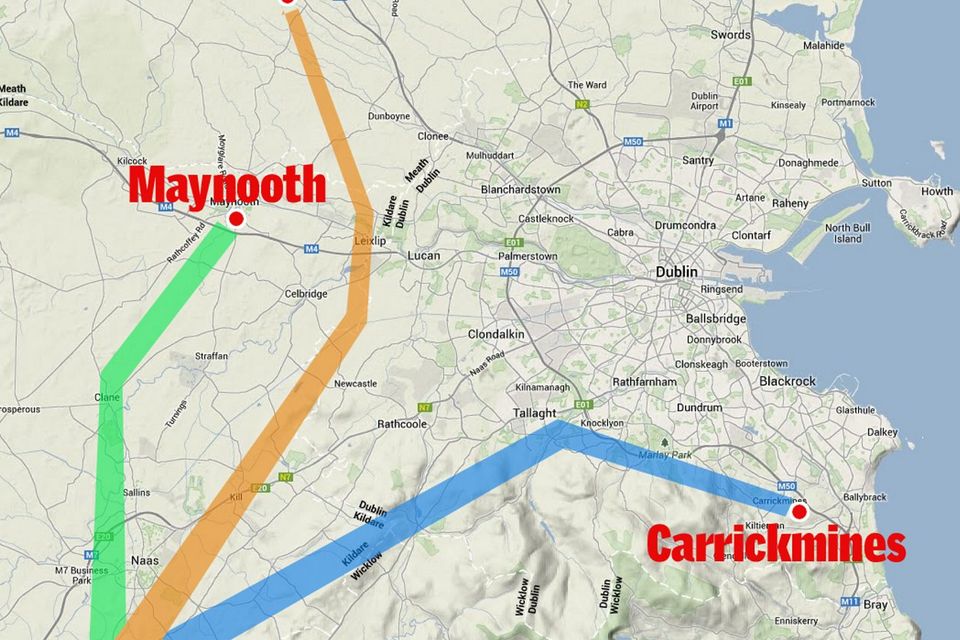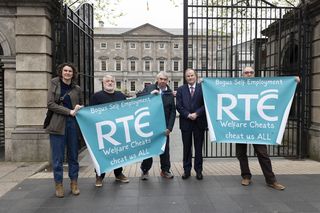Huge 'second wave' of pylons planned
The proposed route of the pylons
A massive "second wave" of pylon projects is now being planned by EirGrid that will bring 45-metre towers into the heart of the Dublin commuter belt.
Despite initial denials by EirGrid, a key EU agency in charge of developing power structures throughout Europe has confirmed the proposals to the Sunday Independent.
EirGrid is still embroiled in controversy and a near national revolt over its current plans for rural Ireland. Taoiseach Enda Kenny has called for more transparency in their dealings with the public.
Under the current "first wave" Grid Link proposals, some 1,300 pylons will run across the country from Cork to Great Island in Wexford to Dunstown in Kilcullen in south Kildare on a cross-country corridor yet to be decided.
However, now the Sunday Independent has confirmed further proposed routes, which will link the Dunstown "hub" with the greater Dublin area and the UK.
The Sunday Independent has learnt that proposals for four extra routes out of Dunstown in Co Kildare, and one additional route from Great Island in Wexford to Le Martyre in France, were submitted by EirGrid to the European Transmissions System Operations of Electricity (ENTSO-E) as part of the EU agency's Ten Year Network Development Plan (TYNDP) 2012.
Among proposed routes are corridors from Dunstown to Maynooth in north Kildare; Dunstown to Carrickmines in south county Dublin; and Dunstown to Pentir in Wales. A further route has also been added to the proposal list, potentially linking Dunstown to the existing Woodland ESB substation at Batterstown between Dunboyne and Dunshaughlin, Co Meath.
Also included in the ENTSO-E July 2013 update to the 2012 plan is a further proposed route linking Great Island in Wexford to France.
When first contacted by the Sunday Independent, EirGrid denied a second wave of pylon projects was already being planned.
"Apart from the project Grid Link there are no further projects to go into Dunstown," a spokesperson for EirGrid said just weeks ago, when queried on the proposals for the five additional routes.
"None of these projects are EirGrid projects," the spokesperson continued.
"They are nothing to do with EirGrid. The only concrete project is Grid Link."
When questioned about the documentation lodged with ENTSO-E, the spokesman added that the proposed plans submitted to EU agency under the 2012 report were simply, "a list of potential concepts which are submitted by third parties" and "produced based on third-party information".
However, a spokesperson for ENTSO-E stated: "I can confirm that the TYNDP 2012 does not contain projects from third-party promoters. The projects you refer to in the 2012 TYNDP were submitted by the Irish Transmission System Operator, EirGrid."
When contacted again, EirGrid's response changed.
"Every transmission system operator, including EirGrid, submits its plans for major infrastructure developments to ENTSO-E for inclusion in the TYNDP. Those plans can include projects at any stage of development from early to advanced. Projects at a very early conceptual stage are given a status 'under consideration' in the TYNDP, meaning no decision has been made to progress them."
"A number of projects in the TYNDP which are shown as relating to Dunstown substation are in this 'under consideration' category," the spokesperson added.
"Please note that these projects are at a very early investigation stage; no decision has been taken by EirGrid with respect to progressing these projects," the spokesperson said in an email response.
When contacted a third time to explain the discrepancies in EirGrid's response to the Sunday Independent's queries, a spokesman said that the "mix-up" had been a "genuine mistake" resulting from a separate media inquiry involving other projects that had not been submitted to the ENTSO-E by EirGrid.
EirGrid has already faced a wave of criticism over its perceived failure to adequately inform communities about its long-term plans.
It led Taoiseach Enda Kenny to issue a sharp rebuke to the semi-State agency.
Mr Kenny stressed, "communication must be real" and take on board public concerns.
"I know that in some cases these consultations have not been as full as I would like. There is a need for a balanced and rational discussion on what we want to do."
Fianna Fail leader Michael Martin has already called for an independent international assessment of EirGrid's 25 proposals on the upgrade and expansion of the national grid using only overground pylons.
On December 23, members of Kildare County Council called on the county management to review their County Development Plan covering 2011-2017, because when the plan was drawn up, none of EirGrid's current Grid Link plans were made known to the council, even though the company is believed to have been planning the "first wave" Grid Link project well in advance of this.
"I don't believe that anyone wants to stop the infrastructure going ahead, but it's the manner in which it is being proposed," local Fianna Fail councillor Martin Miley told the meeting.
"EirGrid were well aware of the plans they had for our county when the development plan was being drawn up, but they stated that upgrading the existing lines was all that they were looking at."
Others pointed to what they alleged was a "systematic failure" by EirGrid to inform people of their overall national plan -- whether conceptual or not.
"With the future plans that EirGrid have for Dunstown, it's going to become a spaghetti junction over the next few years," councillor Ivan Keatley of Fine Gael added, before calling on EirGrid to cease its "piece-meal" method of informing the public about their intentions for both Kildare and the whole of Ireland.
"There are plans for Dunstown and they haven't put any of those plans into the Grid Link project," he added. "Quite clearly it would be a lot more beneficial for the people of Kildare and the country to know what's going to be there in ten years time and not dealing with everything bit by bit."
The wave of public protest has led to dozens of community groups springing up around the country, including the emergence of a national alliance movement called SOUL (Save Our Underground Lines) loosely based on a GAA-style "club" structure designed to heap pressure on politicians in advance of next year's local and European elections.
EirGrid argues that the company's public consultation process has been "a genuine and extensive effort to gather and address information provided by communities."
"The Grid Link Project is still in the pre-planning stage and after January 7, people can still engage with the project," an EirGrid spokesperson said.
Join the Irish Independent WhatsApp channel
Stay up to date with all the latest news














